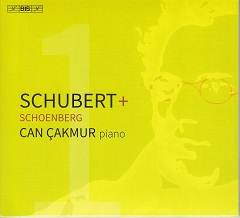Die Sonate D 537 vom 19-jährigen Franz Schubert, seine Vierte und die erste, die er fertiggestellt hat, ist ein Werk, in dem die Keime der Schubertschen Musikessenz enthalten sind. Can Cakmur spielt sie kontrastreich, mit der Juxtaposition von Zartestem und Heftigstem, die den Hörer immer wieder aufschreckt. Verwirrend ist ja auch das Andantino, mit seinen Konflikten und bösen Vorahnungen. Das alles klingt bei Cakmur sehr persönlich, und diesen eigenwilligen Charakter hält der junge Pianist auch im Finalsatz bei, in dem er die ungewöhnlichen Pausen ungemein ausdrucksvoll einsetzt.
Um dem Titel Schubert+ gerecht zu werden, fügt Cakmur zwischen beide Schubert-Sonaten die Drei Klavierstücke von Arnold Schönberg ein, die dem Pianisten sehr gut gelingen. Klarheit, Intelligenz und Sinn für die komplexe Rhythmik der Musik schaffen vollauf überzeugende und in ihrer Rhetorik packende Interpretationen.
Und aus Schönbergs Welt kommend, lässt Cakmur das Allegro der Schubert-Sonate D 959 rhythmisch sehr eigenwillig und modern werden.
Auch das Andantino ist rhythmisch interessant, wie ein unsicheres, angsterfülltes Vorwärtstasten. Das koboldhaft verzerrte Scherzo führt zum Finalsatz, in dem es zwar auch so manch charmante Passage gibt, aber Cakmur schafft mit dynamischen Kontrasten auch in diesem Allegretto eine Welt voller Unsicherheit, mit dunklen Tönen, die die Unbeschwertheit immer wieder stören.
Es ist offensichtlich, dass Cakmur sorgfältig über Struktur, Texturschichtung, Farbwechsel und Dynamik nachgedacht hat – was ich in diesem ganzen Programm besonders bereichernd finde.
Die Tonaufnahme ist vorzüglich, der Klavierklang hat bei aller Direktheit viel Relief,nund der Shigeru Kawai Flügel klingt warm und klar, ohne jede Schärfe.
The Sonata D 537 by the 19-year-old Franz Schubert, his fourth and the first he completed, is a work that contains the germs of Schubert’s musical essence. Can Cakmur plays it full of contrasts, with the juxtaposition of the most delicate and the most violent, which always startles the listener. The Andantino is also confusing, with its conflicts and evil forebodings. It all sounds very personal in Cakmur’s playing, and the young pianist maintains this distinctive character in the final movement, where he uses the unusual rests with immense expressiveness.
To do justice to the title Schubert+, Cakmur inserts Arnold Schoenberg’s Three Piano Pieces between the two Schubert sonatas, and the pianist succeeds very well in tis composition. Clarity, intelligence and a sense of the music’s complex rhythms generate fully convincing interpretations that are gripping in their rhetoric.
And coming from Schoenberg’s world, Cakmur makes the Allegro of the Schubert Sonata D 959 rhythmically very idiosyncratic and modern.
The Andantino is also rhythmically interesting, like an uncertain, angst-filled groping forward. The impishly distorted Scherzo leads to the final movement, in which there are many a charming passage, but Cakmur uses dynamic contrasts to create a world of uncertainty in this Allegretto as well, with dark tones that continually disturb the lightheartedness.
It’s obvious that Cakmur has thought carefully about texture, textural layering, color changes, and dynamics-which I find particularly enriching throughout this program.
The sound recording is excellent, the piano sound has plenty of relief for all its directness, and the Shigeru Kawai grand sounds warm and clear, without any sharpness.


















